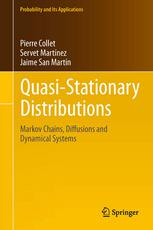

Most ebook files are in PDF format, so you can easily read them using various software such as Foxit Reader or directly on the Google Chrome browser.
Some ebook files are released by publishers in other formats such as .awz, .mobi, .epub, .fb2, etc. You may need to install specific software to read these formats on mobile/PC, such as Calibre.
Please read the tutorial at this link: https://ebookbell.com/faq
We offer FREE conversion to the popular formats you request; however, this may take some time. Therefore, right after payment, please email us, and we will try to provide the service as quickly as possible.
For some exceptional file formats or broken links (if any), please refrain from opening any disputes. Instead, email us first, and we will try to assist within a maximum of 6 hours.
EbookBell Team

0.0
0 reviewsMain concepts of quasi-stationary distributions (QSDs) for killed processes are the focus of the present volume. For diffusions, the killing is at the boundary and for dynamical systems there is a trap. The authors present the QSDs as the ones that allow describing the long-term behavior conditioned to not being killed. Studies in this research area started with Kolmogorov and Yaglom and in the last few decades have received a great deal of attention. The authors provide the exponential distribution property of the killing time for QSDs, present the more general result on their existence and study the process of trajectories that survive forever. For birth-and-death chains and diffusions, the existence of a single or a continuum of QSDs is described. They study the convergence to the extremal QSD and give the classification of the survival process. In this monograph, the authors discuss Gibbs QSDs for symbolic systems and absolutely continuous QSDs for repellers.
The findings described are relevant to researchers in the fields of Markov chains, diffusions, potential theory, dynamical systems, and in areas where extinction is a central concept. The theory is illustrated with numerous examples. The volume uniquely presents the distribution behavior of individuals who survive in a decaying population for a very long time. It also provides the background for applications in mathematical ecology, statistical physics, computer sciences, and economics.